Theoson-Jordan Siebatcheu, now known as Jordan Pefok by his request, is a physical forward eyeing a place at the 2022 World Cup in Qatar with the USMNT. Born in Washington D.C, Pefok grew up in France with Cameroonian parents. Eligible for these three nations, the striker was capped at Under-21 level with France in June 2017 but has since committed to the United States, making nine appearances since his debut in 2021.
After coming through the academy at Stade de Reims, Pefok scored on his second Ligue 1 appearance for the club against Bordeaux. However, his season in Ligue 2 with Reims was the breakout year of his career. As Reims won the Ligue 2 title and gained promotion back to the top division, Pefok scored 17 goals and registered seven assists. This attracted interest from multiple Ligue 1 sides and the striker joined Rennes in the summer of 2018.
After an unsuccessful spell at Rennes, struggling for minutes and goals, Pefok was loaned to Young Boys of Bern, Switzerland. Bagging 15 goals for Young Boys, his move was made permanent the following summer ahead of the 2021/22 campaign. Last season was Pefok’s best season so far, scoring 27 goals in all competitions, including a last-minute winner against Manchester United in the UEFA Champions League group stage. He became the first American to win the golden boot in a European league, finding the net 22 times in the Swiss Super League.
Last season’s success earned Pefok a move to Union Berlin, who had just finished 5th in the Bundesliga, meriting Europa League football, in Die Eisernen’s best ever season. An exciting campaign lies ahead at the Stadion An der Alten Försterei for both club and player. Helping to replace the departure of £20m Taiwo Awoniyi to Nottingham Forest, Pefok was signed for just over £5m and has already hit the ground running. Registering a combined five goals and assists in his first five appearances, the American has impressed instantly in a decisive period for the USMNT World Cup selection.
This tactical analysis, in the form of a scout report, will look at Jordan Pefok’s role at Union Berlin and identify his qualities that could lead to a place in the United States squad at the World Cup.
Player profile
Jordan Pefok (190cm/6’3”, 86kg/189lbs) is a right-footed striker with an athletic build. Capable of challenging any centre-back due to his exceptional strength, the 26-year-old is also a lethal goal scorer. Extremely effective with his back to goal, the American’s hold-up play is a great outlet to gain territory for his team. His outlet role can also relieve pressure in the build-up phase and provide the verticality required in attacking transitions. This is particularly essential for Union Berlin’s tactics under Urs Fischer.
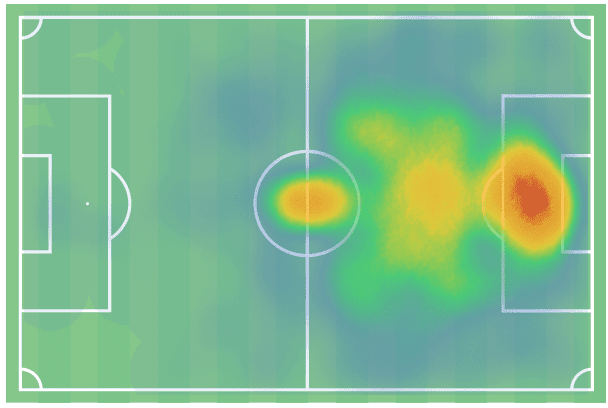
The image above displays Pefok’s heatmap from the 2021/22 season with Young Boys. Based on the small sample size of the American’s first few appearances at Union Berlin, his position and heatmap look similar to last season. With David Wagner at the helm, Young Boys deployed a 4-4-2 for the vast majority of the season. As a result, Pefok would often be working in a two-man strike partnership. Playing 3,162 minutes in all competitions, Pefok was Young Boys’ most used centre-forward.
In a strike partnership with Meschack Elia (173cm/5’8”) or Wilfried Kanga (189cm/6’2”), Pefok has experience playing alongside different striker profiles. Elia thrives in transitions and when given space to utilise his electric pace. Kanga has a bit more variety to his game, typically preferring the ball to feet. He becomes alive in the final third and is a relentless presser. His experience of different partnerships has benefitted his new pairing at Union Berlin with Sheraldo Becker. Becker’s five goals in five games has already bettered his Bundesliga tally from last season. Despite exclusively lining up in a 4-3-3 in their recent games under Gregg Berhalter, this trait could help Pefok’s possibility of representing the United States at the World Cup.
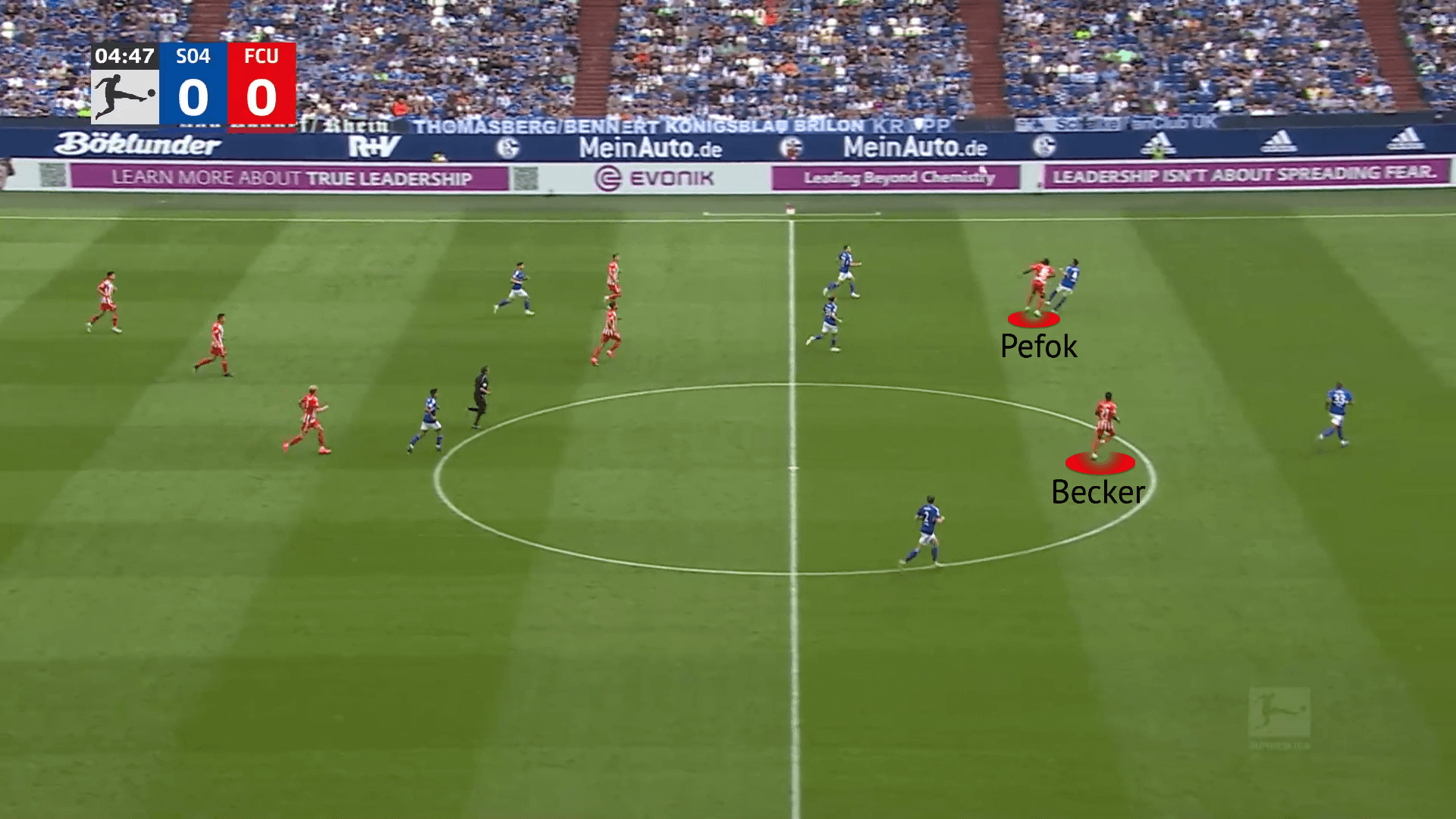
These two figures above and below provide a representation of Pefok’s unstoppable physicality and the dangerous duo with Becker. As Niko Gießelmann has launched a clearance beyond the half-way line, Pefok contests a tussle with Maya Yoshida. The former Southampton centre-back can’t deal with the American’s superior strength, losing his balance after attempting to nudge the immovable striker. As a result, Pefok can bring the ball down and hold off the FC Schalke 04 defender before releasing Becker and receiving a clattering from Yoshida. Becker’s shot from a wide angle forced a good stop from Schalke goalkeeper Alexander Schwolow.
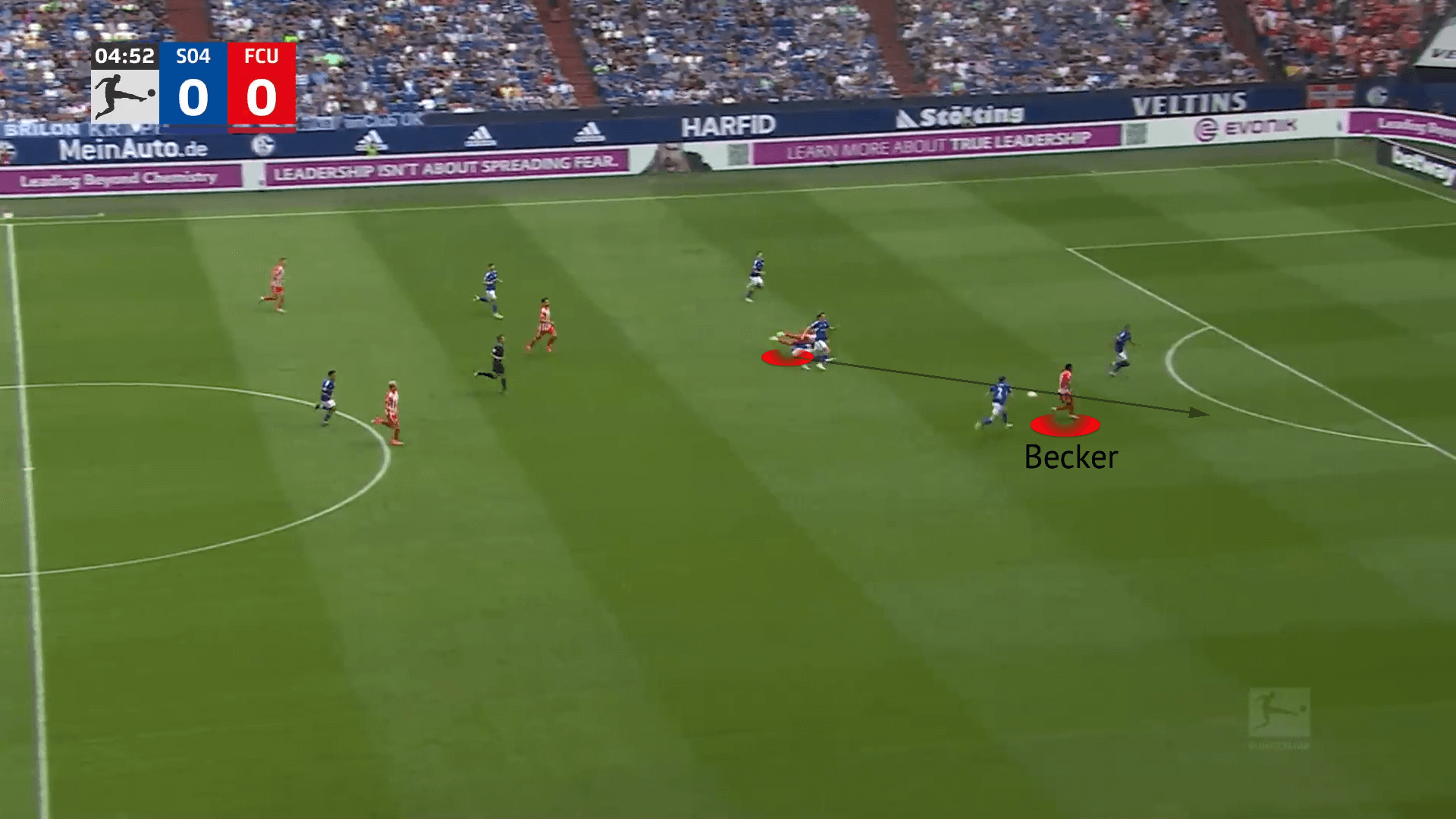
Role as an outlet
Union Berlin manager Urs Fischer’s succinct style of play is a radical difference from the German giants around Die Eisernen in the Bundesliga table. With the lowest average possession in the league with 38.9%, they struggle with ball retention. However, this does not impact their success, as Union Berlin have a preference to sit back before erupting into a ferocious counterattack with their more direct approach.
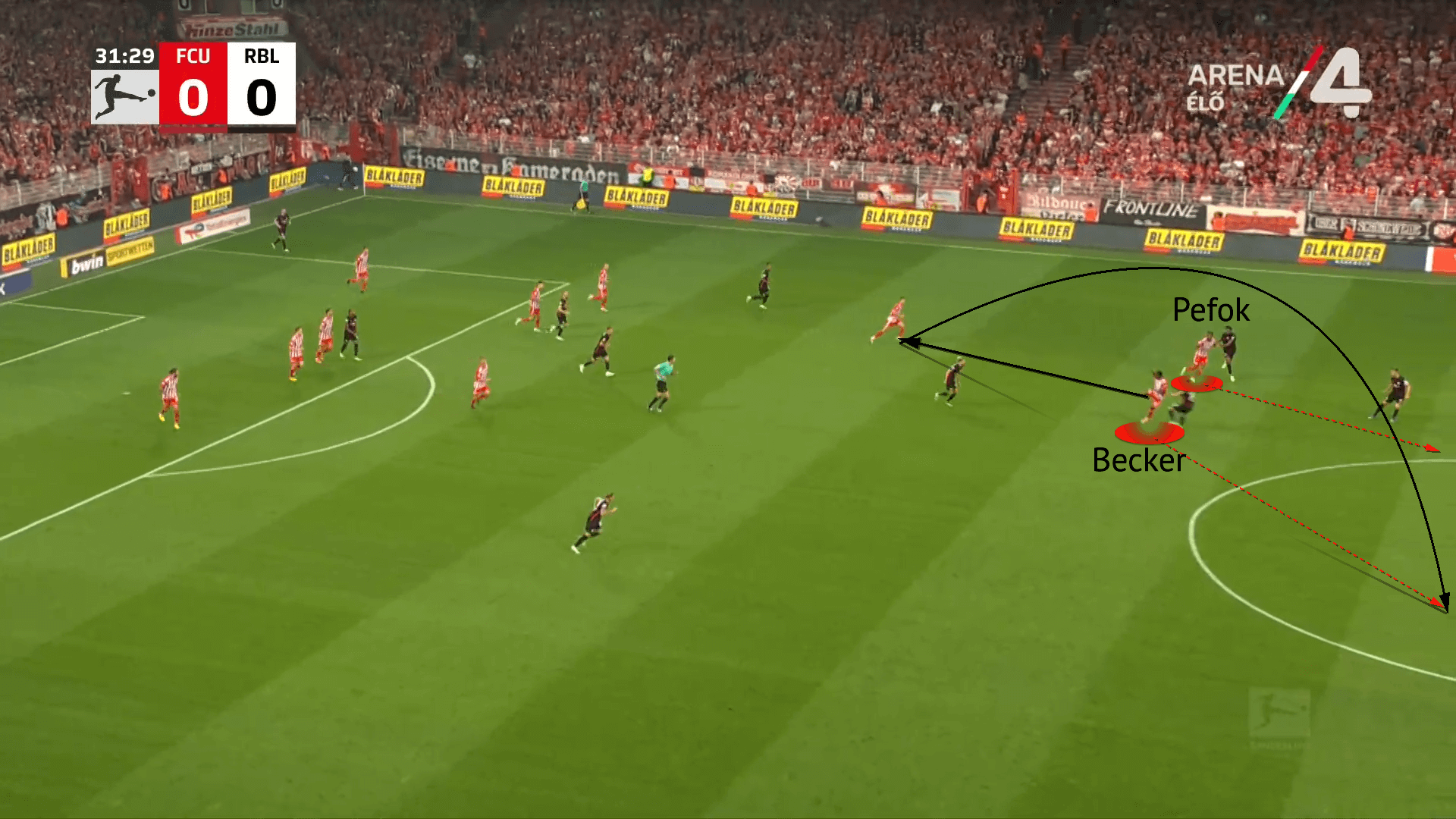
These next few images show a lightning counterattack from Union Berlin against RB Leipzig ending with a Jordan Pefok goal. Winning back possession after RB Leipzig entered the final third, a long ball was played up towards the front two of Pefok and Sheraldo Becker.
By remaining close to each other, the attacking pair can link up with passes and manipulate the positioning of opposition defenders, potentially drawing them in to then burst away with their superior power. As the ball finds box-to-box midfielder Janik Haberer, Pefok and Becker begin their sprints past RB Leipzig’s defenders.
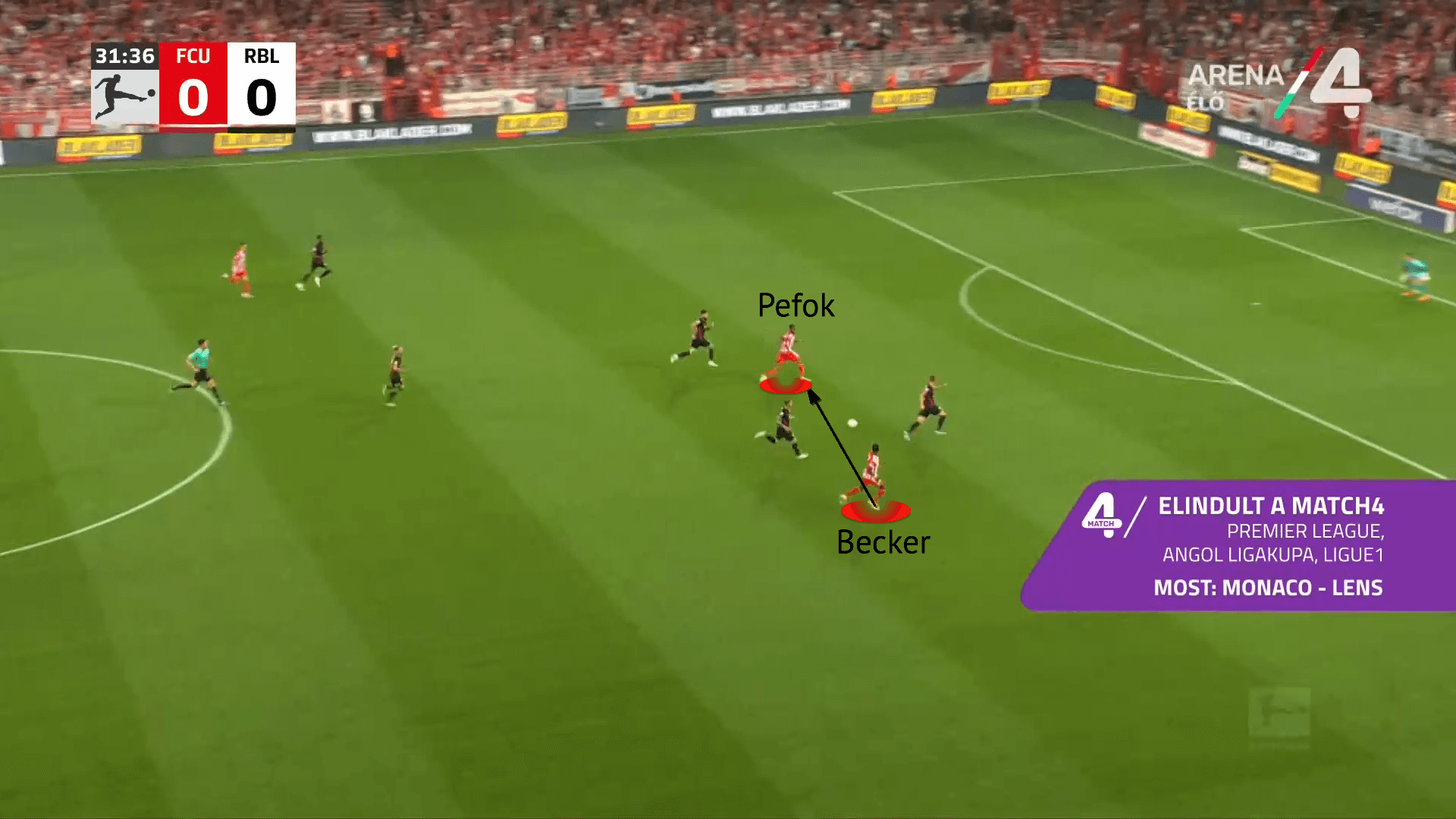
Haberer manages to thread an excellent pass into space for Becker to make use of his rapid pace. With Becker driving forwards, Pefok’s understanding and intent to find space means he makes a movement to split centre-back, Willi Orbán.
With David Raum and Joško Gvardiol still trying to recover in defensive transition, Orbán was forced to either cut the passing lane into Pefok and allow Becker through on goal or leave Pefok and close down Becker. The Hungarian centre-back was punished for leaving Pefok, with the American finding the bottom left corner beyond Leipzig’s backup goalkeeper Janis Blaswich.
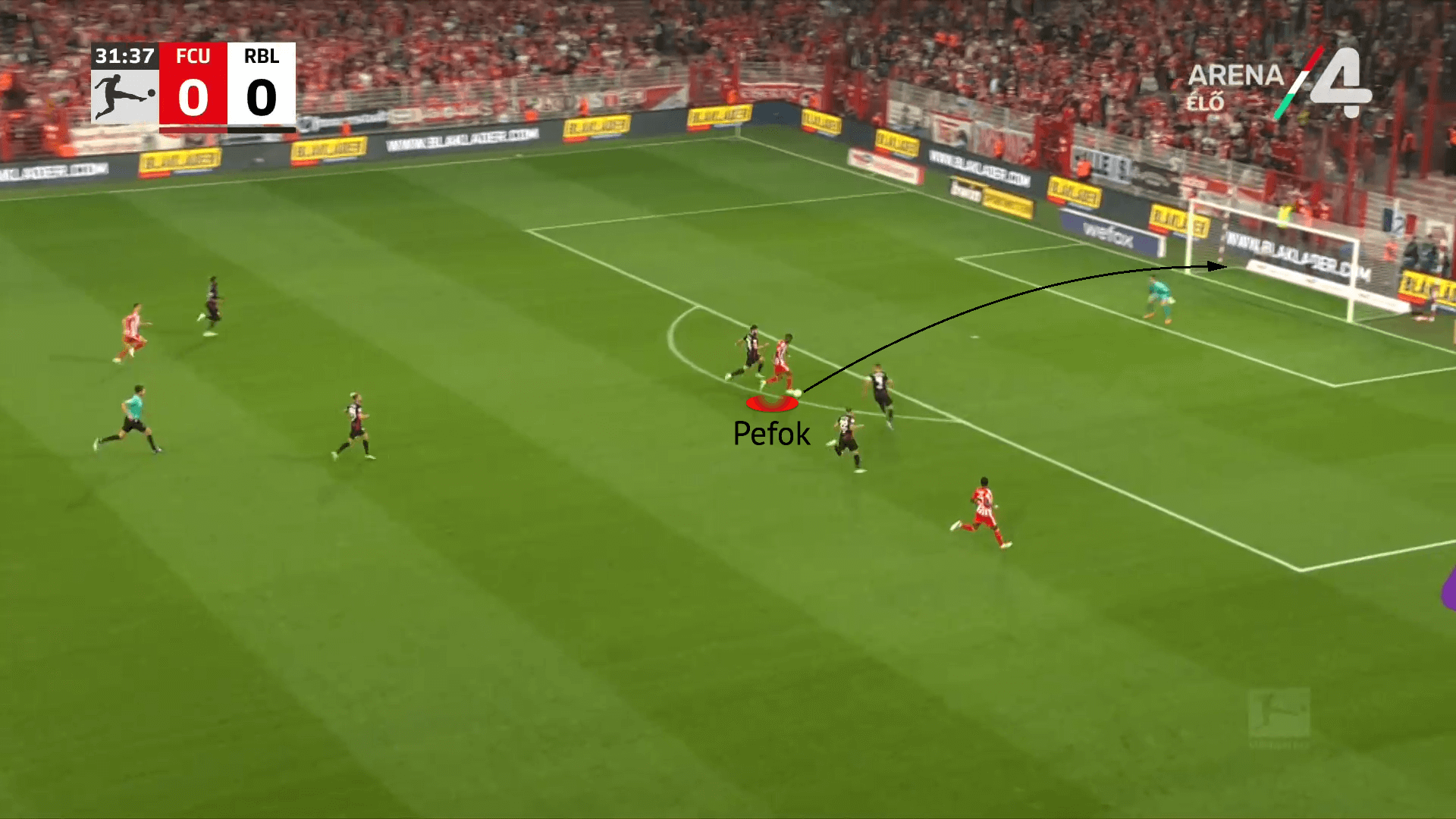
Pefok and Becker’s ability to find space in transition has been a key feature of Union Berlin’s attacking play this season. With their lack of possession meaning Fischer’s side sit in their 5-3-2 block for most of their matches, Union Berlin must spring out into their 3-1-4-2 attacking shape to make their attacking transitions count. They counterattack with verticality in both on and off-the-ball forward movements, committing several players.
Die Eisernen’s direct approach limits the opposition’s ability to recover their shape, with Union Berlin’s attackers not afraid of shooting from distance and when under pressure.
With committing multiple players forward, Union Berlin’s attacks have a lot of fluidity. Pefok and Becker will move into their respective channels, chasing down long balls and providing overloads. This also creates space for the central midfielders to attack the box. This is not where Pefok is most effective, but his gravity to attract opposition into wide areas can be beneficial.
Pefok is brilliant in central areas with his back to goal. His hold-up play is excellent, aided by his complete physical attributes. He is able to shield possession whilst receiving pressure from behind, which in turn draws opposition midfielders to provide pressure from in front. This helps create space for bounce passes to Union Berlin’s central midfielders, facilitating potential up-back-through combinations for Becker’s in-behind runs, like seen above against RB Leipzig.
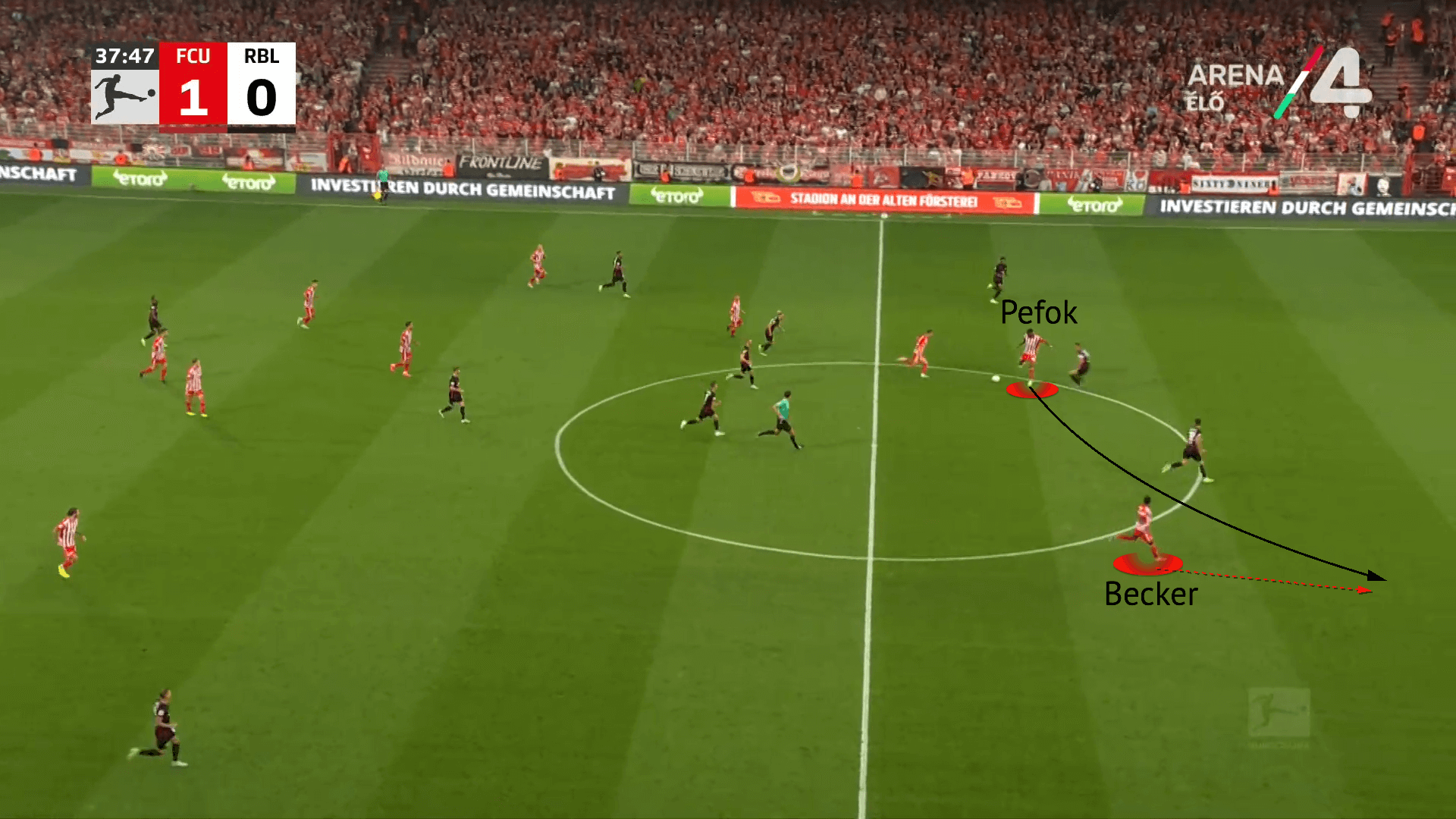
Pefok has rarely been influential in deeper phases of structured possession during his career. Despite Young Boys having the second highest average possession in the Swiss Super League last season, Pefok only averaged 15 passes per 90. Although his passing accuracy of 82.2% ranked 4th out of the 53 strikers to play over 500 minutes in the Swiss Super League last season. His 2.67 forward passes per 90 ranked 49th, indicating his maximum influence is by occupying the centre-backs rather than acting as a progressor from deep. This is further supported by his 1.21 passes into the final third per 90, which ranked 46th.
Nevertheless, Pefok does have some passing traits and habits that can be particularly effective for Union Berlin. Despite the quite clear deficiencies in his passing game, Pefok’s ability to release passes at the optimal time to retain possession and trigger attacking moves is suited to a transition side. In the image above, Urs Fischer’s side have regained possession and completed the pass into Pefok to start a counterattack. With RB Leipzig centre-back Orbán ready to pounce on Pefok’s first touch, the American plays a first-time pass into Becker. Orbán collides with Pefok, fouling the striker, and is unable to get back into position. This left Becker 1vs1 against Gvardiol, with Becker cutting inside after entering the box to score from an angle that Orbán should be covering.
Pefok’s ability to hold up play despite opposition pressure yet still release the ball to retain possession is an extremely useful asset to prevent Union Berlin’s opponents from sustained periods of possession. In their 5-3-2 out of possession shape, Die Eisernen will maintain compactness in central areas. The attackers don’t press with much intensity, but if Pefok presses then Becker will drop in to screen the opposition pivot player to prevent them from receiving.
Pefok drops back onto the pivot player too if Becker presses but this rarely happens with Union Berlin’s 17.19 PPDA, the second-highest in the league. When Union Berlin are defending the box, one of the central midfielders will drop in to provide an additional box presence. This means an attacker will also drop back to help fill the gap, leaving just one attacker forwards for the transition. As a sole transitional outlet, Pefok’s aforementioned hold-up play is crucial.
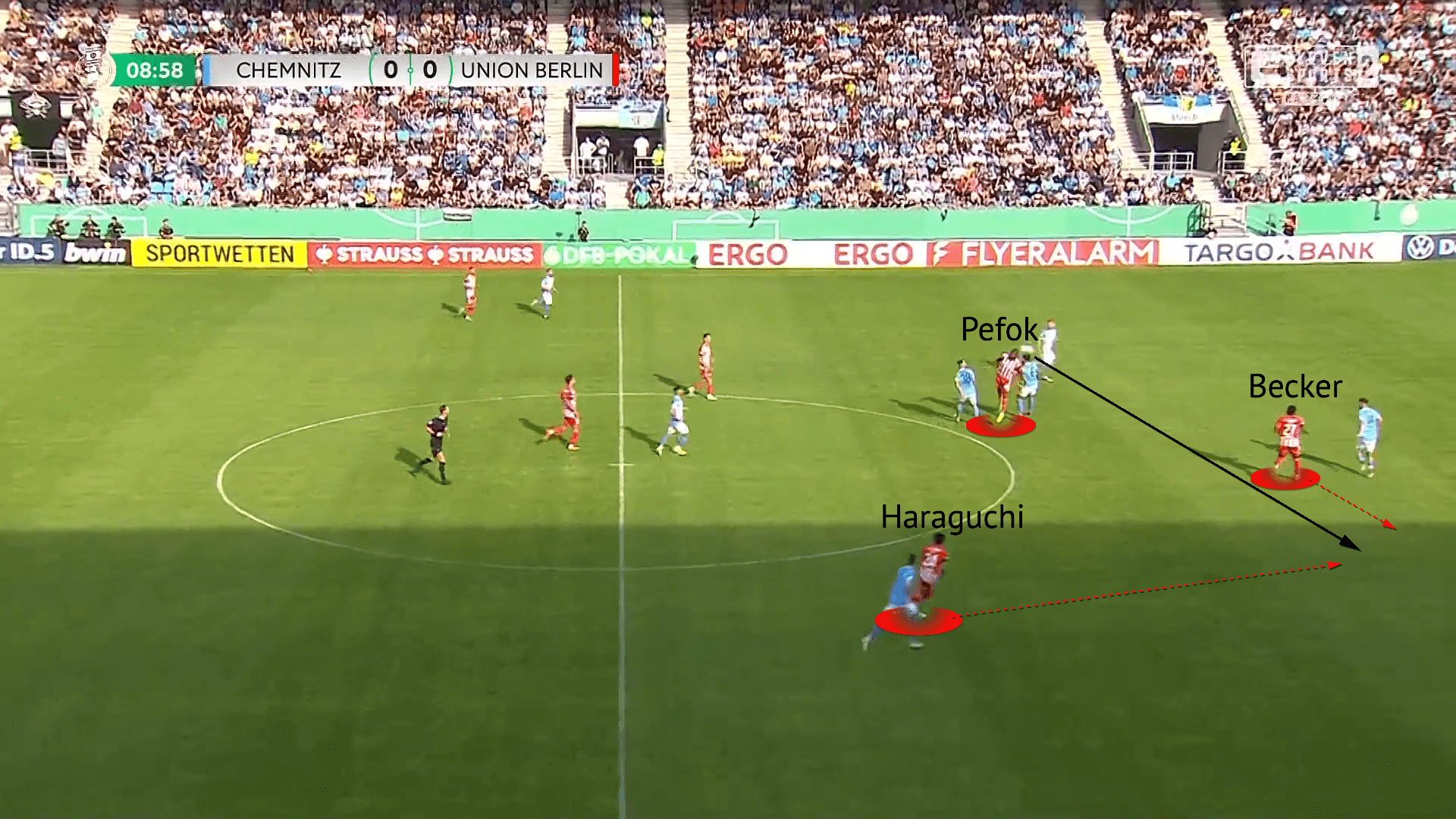
Pefok is also an outlet for Union Berlin’s build-up. Fischer’s side typically build up in a 3-1 shape with Rani Khedira at the tip of the diamond, although they can push one of the outer centre-backs wider to allow the wing-back to advance. The centre-midfielders other than Khedira rarely influence build-up, occupying a higher position instead to recover second balls from the strikers. Die Eisernen’s build-up usually goes long to the strikers, and goalkeeper Frederik Rønnow will launch passes towards the powerful forwards when under any pressure.
This is where Pefok flourishes, having a great impact against opposition centre-backs to help Union Berlin. From his 5.16 aerial duels per 90 for Young Boys in the Swiss Super League, the American’s 54.61% success rate ranked 2nd out of the 53 strikers. Pefok’s superb aerial ability compliments Becker’s pace and movement in behind opposition defences.
In the figure above, Union Berlin centre-back Paul Jaeckel has played a pass to Rønnow that is tough for the goalkeeper to control. This attracts pressure from Chemnitzer striker Felix Brügmann and forces Rønnow to clear the ball. Pefok dominates the aerial duel and flicks the ball on towards Genki Haraguchi, but the Japanese midfielder left it for Becker whose shot went over the bar.
Final third impact
With Union Berlin having few attacks as a result of Urs Fischer’s tactics to absorb pressure before attacking at pace in transition, their attacking play must be efficient. Additionally, only four teams have taken fewer shots in the Bundesliga this season than Die Eisernen, and their 4.12 xG is the second lowest in the league. Despite their poor 4.12 xG, Union Berlin have scored 12 goals, the second highest in the league so far.
The figure below displays Jordan Pefok’s shots for Young Boys in the Swiss Super League last season. Green dots are goals; pink dots are shots on target; pink circles are missed shots. We can see that Pefok mainly shoots from inside the box, boosting his xG and xG per shot. His 0.2 xG per shot is generally very good when compared to Europe’s strikers. For example, Dušan Vlahović of Juventus, Victor Osimhen of Napoli, and Patrik Schick of Bayer Leverkusen have a lower xG per shot than Pefok from their last 100 shots.
His determination to occupy a position between the posts and inside the box is crucial to Union Berlin overperforming xG for the rest of the season. Although his xG per shot will drop at Union Berlin, his attacking positioning will help the American accumulate high-quality chances.
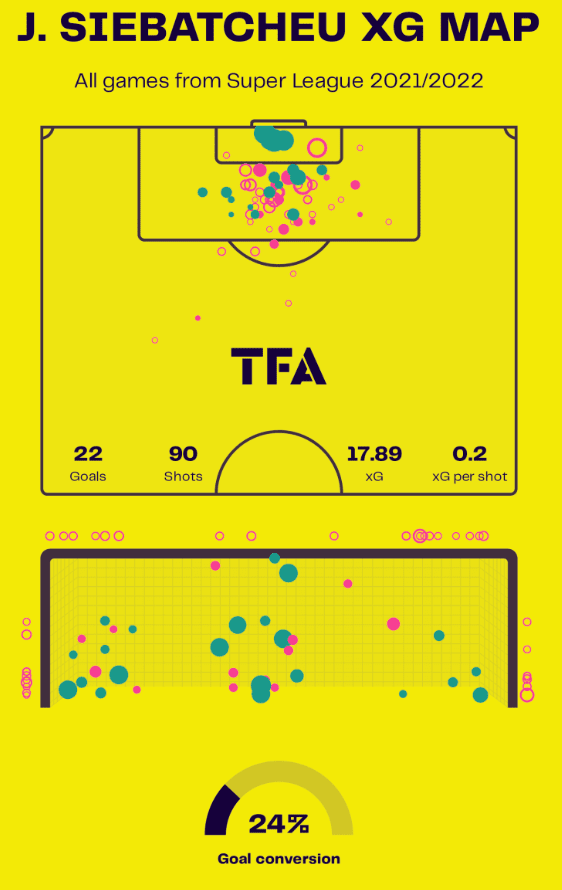
Pefok’s shooting technique is not the easiest on the eye, but what matters is his ability to put the ball in the back of the net. With his positioning and physical presence making him a threat from all types of deliveries from wide areas, he is able to score a variety of chances.
His first Bundesliga goal for Union Berlin was header from an acute angle at the near post, getting across his man to divert Sheraldo Becker’s cross into the far corner. Pefok strikes volleys with power, bound to trouble goalkeepers due to the ferocity. His ability to hit a bouncing ball also creates unexpected shooting angles and more speculative opportunities. For example, his first competitive Union Berlin goal was a bicycle kick equaliser in the DFB-Pokal against Chemnitzer, catching the goalkeeper by surprise.
The American is also a threat from set-pieces. He remains alive for second phases from set-pieces and looks to attack the front post from Union Berlin corners. His aerial ability has been valuable at Union Berlin so far defensively as well, with Pefok being a zonal marker for the front zone from opposition corners. Furthermore, Pefok’s final goal for Young Boys was a last-minute winner from the penalty spot against FC Sion. He had scored all eleven penalties he had taken in his senior career until his miss against FC Köln yesterday.
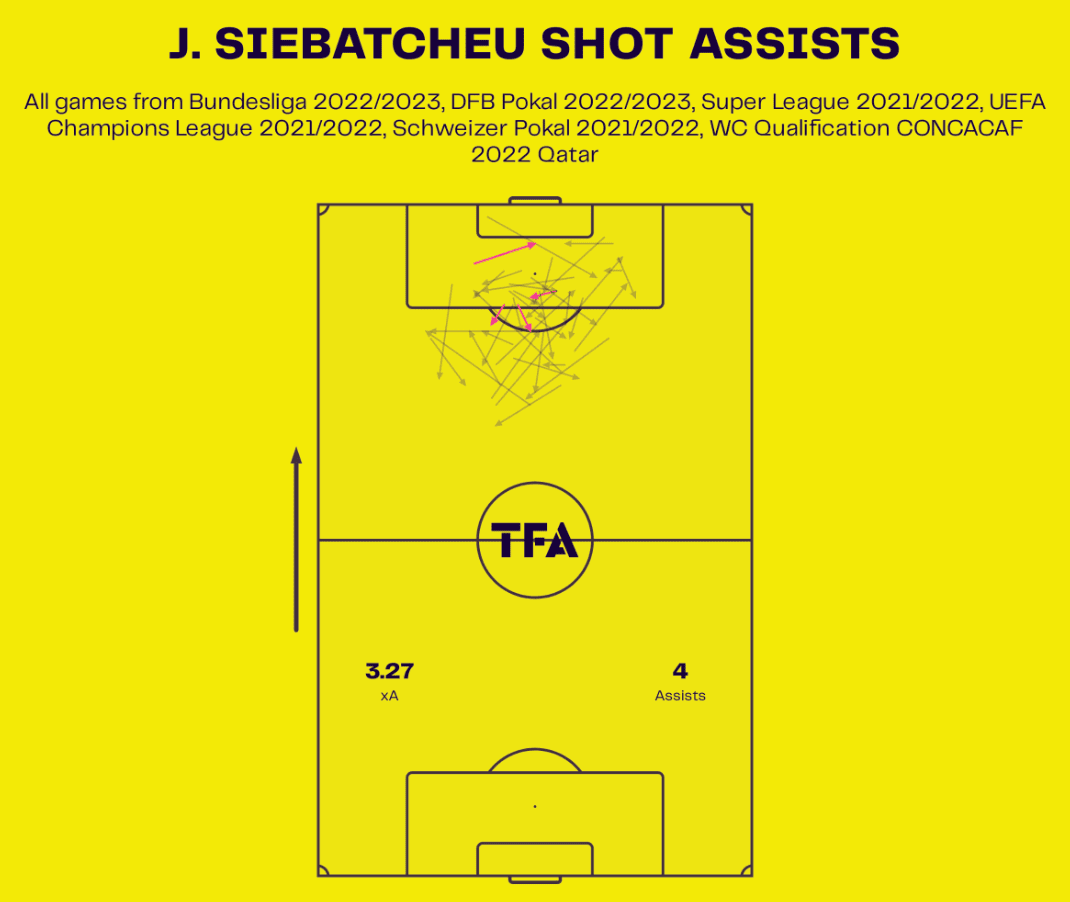
The 26-year-old striker can be clinical inside the box, but he rarely finds the back of the net from outside the box. However, Pefok is still able to utilise his excellent hold-up play to create chances from around the edge of the box. As we mentioned earlier, his superior strength with his back to goal for hold-up play attracts multiple opponents. By drawing in pressure from opposition midfielders as well as the defenders on his back, he can release the ball to create shooting opportunities for his midfield teammates.
The figure above displays Pefok’s shot assists since the start of the 2021/22 season. The number of backwards passes, especially around the edge of the penalty box, shows how the American is effectively deploying his strength and hold-up play to create shots.
An example of this can be seen below against Mainz 05. Receiving the ball inside the box with his back to goal, Pefok resists the pressure from behind from Stefan Bell. Taking quite a heavy first touch, Pefok has attracted midfielder Anton Stach to the ball. This has allowed Union Berlin midfielder Rani Khedira to move into space and create the shooting angle.
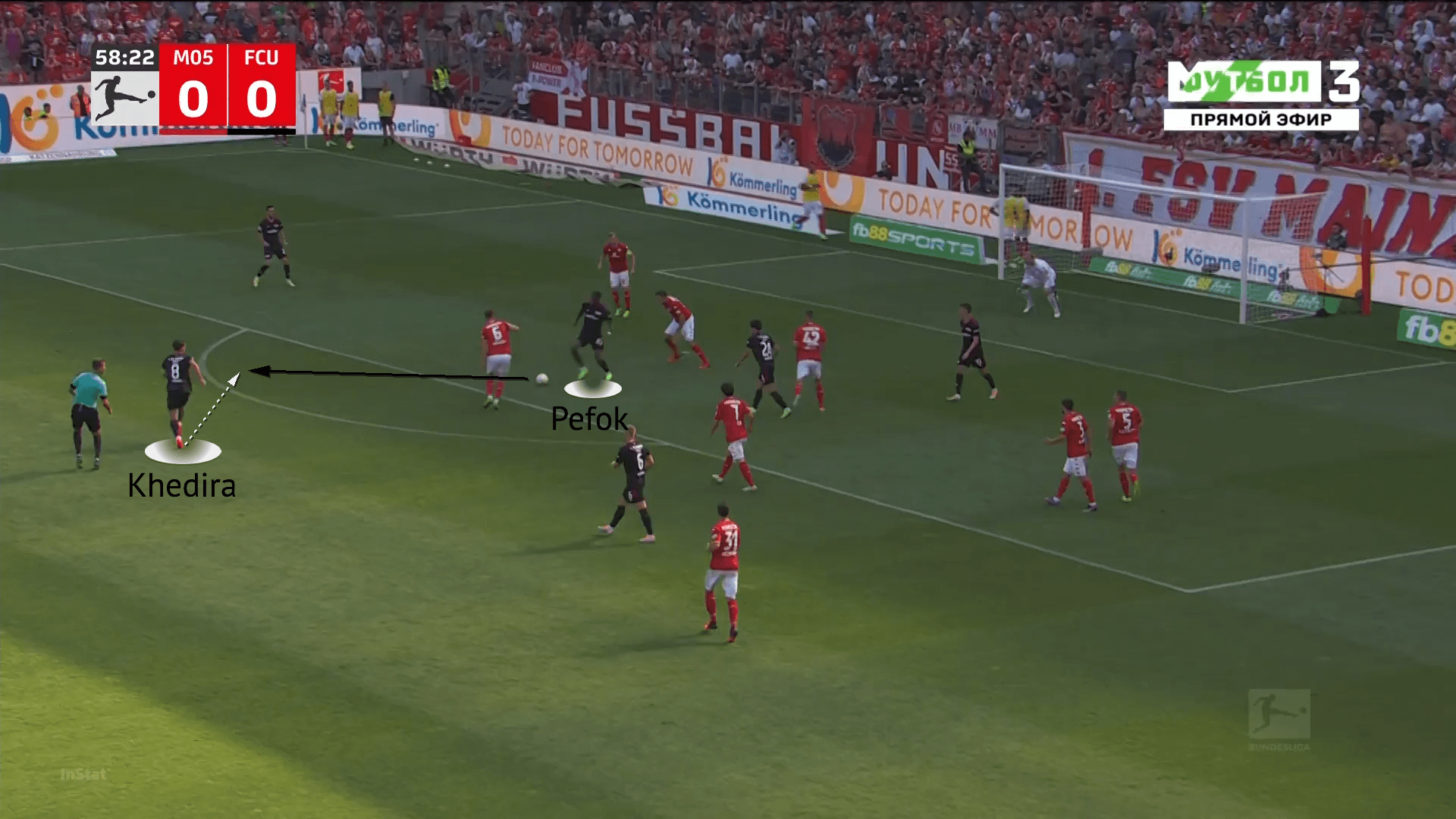
Conclusion
As Union Berlin embark on a monumental Europa League campaign off the back of a club-best Bundesliga finish, Die Eisernen will be relying on attackers Jordan Pefok and Sheraldo Becker to find goals from minimal ball possession. In Pefok, they have an American international that suits the succinct style of play of manager Urs Fischer.
Physically excellent, Pefok possesses the strength required to utilise his hold-up play and be an outlet. He is able to combine with teammates with his back to goal in all areas of the pitch, from the halfway line to inside the penalty box. He can also be a transitional outlet, with his ability to find space to penetrate against unsettled defences.
Pefok also makes a difference in the final third, already contributing five goals and assists in his first five appearances for Union Berlin. This includes goals to take the lead in wins against Champions League side RB Leipzig and against Berlin rivals Hertha BSC. Last season for Young Boys, Pefok scored 22 goals in the Swiss Super League and became the first American to win the golden boot in a European league.
With the 2022 World Cup in Qatar edging closer, Pefok’s goal-scoring might be what puts him ahead of his USMNT striker alternatives. In a recent interview, USMNT head coach Gregg Berhalter named Pefok alongside Jesús Ferreira (FC Dallas), Ricardo Pepi (FC Groningen), Brandon Vazquez (FC Cincinnati), Haji Wright (Antalyaspor), and Josh Sargent (Norwich City) in his striker shortlist for the World Cup. Apart from youngster Pepi, every striker is scoring at club level, giving Berhalter a good headache. However, Pefok is the striker producing at the highest level right now as he aims to represent the United States in Qatar. Despite Berhalter preferring the profiles of Sargent and Ferreira, the different option of Pefok’s robustness will be extremely useful as the USMNT look to progress out of their group containing England, Wales, and Iran.
In this tactical analysis, we have looked at Jordan Pefok’s quality as an outlet for Union Berlin alongside his impact in the final third as he bids to lead the line for the USMNT at the 2022 FIFA World Cup.






Comments